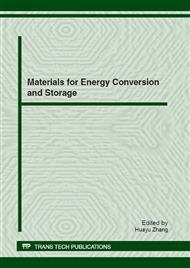[1]
Z.Y. Deng, Y.B. Tang, L.L. Zhu, Y. Sakka, J.H. Ye, Effect of different modification agents on hydrogen-generation by the reaction of Al with water, Int. J. Hydrogen Energy. 35 (2010) 9561-9568.
DOI: 10.1016/j.ijhydene.2010.07.027
Google Scholar
[2]
A.V. Parmuzina, O.V. Kravchenko, Activation of aluminum metal to evolve hydrogen from water, Int. J. Hydrogen Energy. 33 (2008) 3073-3076.
DOI: 10.1016/j.ijhydene.2008.02.025
Google Scholar
[3]
B. Alinejad, K. Mahmoodi, A novel method for generating hydrogen by hydrolysis of highly activated aluminum nanoparticles in pure water, Int. J. Hydrogen Energy. 34 (2009) 7934-7938.
DOI: 10.1016/j.ijhydene.2009.07.028
Google Scholar
[4]
R.F. de Souza, J.C. Padilha, R.S. Gonçalves, M.O.de Souza, J.R. Berthelot, Electrochemical hydrogen production from water electrolysis using ionic liquid as electrolytes: towards the best device, J. Power Sources. 164 (2007) 792-798.
DOI: 10.1016/j.jpowsour.2006.11.049
Google Scholar
[5]
M. Ni, M.K.H. Leung, D.Y.C. Leung, K. Sumathy, A review and recent developments in photocatalytic water-splitting using TiO2 for hydrogen production, Renew. Sust. Energ. Rev. 11 (2007) 401-425.
DOI: 10.1016/j.rser.2005.01.009
Google Scholar
[6]
H.Z. Wang, D.Y.C. Leung, M.K.H. Leung, M. Ni, A review on hydrogen production using aluminum and aluminum alloys, Renew. Sust. Energ. Rev. 13 (2009) 845-853.
DOI: 10.1016/j.rser.2008.02.009
Google Scholar
[7]
E. Czech, T. Troczynski, Hydrogen generation through massive corrosion of deformed aluminum in water, Int. J. Hydrogen Energy. 35 (2010) 1029-1037.
DOI: 10.1016/j.ijhydene.2009.11.085
Google Scholar
[8]
L. Soler, J. Macanás, M. Muñoz, J. Casado, Hydrogen generation from aluminum in a non-consumable potassium hydroxide solution, Proceedings International Hydrogen Energy Congress and Exhibition IHEC 2005 Istanbul, Turkey: 2005, pp.1-7.
DOI: 10.1016/j.ijhydene.2009.08.008
Google Scholar
[9]
A.A. El-Meligi, Hydrogen production by aluminum corrosion in hydrochloric acid and using inhibitors to control hydrogen evolution, Int. J. Hydrogen Energy. 36 (2011) 10600-10607.
DOI: 10.1016/j.ijhydene.2011.05.111
Google Scholar
[10]
M.Q. Fan, F. Xu, L.X. Sun. Studies on hydrogen generation characteristics of hydrolysis of the ball milling Al-based materials in pure water, Int. J. Hydrogen Energy. 32 (2007) 2809-2815.
DOI: 10.1016/j.ijhydene.2006.12.020
Google Scholar
[11]
A.V. Ilyukhina, O.V. Kravchenko, B.M. Bulychev, E.I. Shkolnikov, Mechanochemical activation of aluminum with gallams for hydrogen evolution from water, Int. J. Hydrogen Energy. 35 (2010) 1905-1910.
DOI: 10.1016/j.ijhydene.2009.12.118
Google Scholar
[12]
O.V. Kravchenko, K.N. Semenenko, B.M. Bulychev, K.B. Kalmykov, Activation of aluminum metal and its reaction with water, J. Alloys Compd. 397 (2005) 58-62.
DOI: 10.1016/j.jallcom.2004.11.065
Google Scholar
[13]
S. Liu, M.Q. Fan, C. Wang, Y.X. Huang, D. Chen, L.Q. Bai, K.Y. Shu, Hydrogen generation by hydrolysis of Al−Li−Bi−NaCl mixture with pure water, Int. J. Hydrogen Energy. 37 (2012) 1014-1020.
DOI: 10.1016/j.ijhydene.2011.03.029
Google Scholar
[14]
Chaklader, Hydrogen generation from water split reaction, U.S. Patent 6,582,676 B2 (2003).
Google Scholar
[15]
X.N. Huang, C.J. Lv, Y. Wang, H.Y. Shen, D. Chen, Y.X. Huang, Hydrogen generated from hydrolysis of aluminum/graphite composites with a core-shell structure. doi:10.1016 / j.ijhydene. 2012.01.126.
DOI: 10.1016/j.ijhydene.2012.01.126
Google Scholar
[16]
L. Soler, A.M. Candela, J. Macanás, M. Muñoz, J. Casado, Hydrogen generation by aluminum corrosion in seawater promoted by suspensions of aluminum hydroxide, Int. J. Hydrogen Energy. 34 (2009) 8511-8518.
DOI: 10.1016/j.ijhydene.2009.08.008
Google Scholar
[17]
E. McCafferty, Sequence of steps in the pitting of aluminum by chloride ions, Corros. Sci. 45 (2003) 1421-1438.
DOI: 10.1016/s0010-938x(02)00231-7
Google Scholar
[18]
L. Soler, J. Macanás, M. Muñoz, J. Casado, Aluminum and aluminum alloys as sources of hydrogen for fuel cell applications, J. Power Sources. 169 (2007) 144-149.
DOI: 10.1016/j.jpowsour.2007.01.080
Google Scholar
[19]
X.N. Huang, K. Cao, W. Zeng, C. J. Lv, Da Chen, Y. X. Huang, Hydrogen generation from hydrolysis of ball milled Al/C composite materials: Effects of processing parameters (submitted).
Google Scholar


